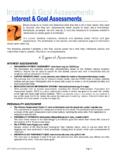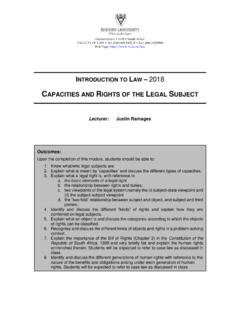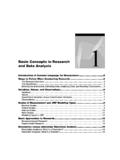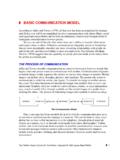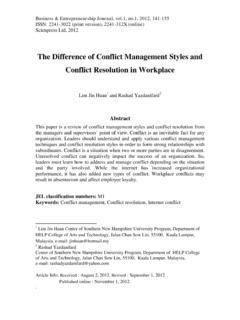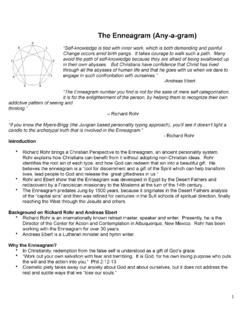Transcription of Assessment and Treatment of Personality Disorders: A ...
1 The Behavior Analyst Today Volume 10, Number 1 7 Assessment and Treatment of Personality Disorders: A Behavioral Perspective Rosemery O. Nelson-Gray, Christopher M. Lootens, John T. Mitchell, Christopher D. Robertson, Natalie E. Hundt, & Nathan A. Kimbrel Abstract Personality disorders are complex and highly challenging to Treatment providers; yet, for clients with these problems, there exist very few Treatment options that have been supported by research. Given the lack of empirically-supported therapies for Personality disorders, it can be difficult to make Treatment decisions for this population. The purpose of this paper is to present our view that basic behavioral principles can be integrated into the Assessment and Treatment of Personality disorders to maximize success with such challenging behavioral patterns. Following a review of well-established behavioral Assessment and Treatment options, we offer additional suggestions upon which to base Treatment : (a) the identification of relevant response classes and (b) the use of functional analysis in Personality disorder Treatment .
2 We conclude with application of the proposed strategies to the examples of borderline and avoidant Personality disorders. Keywords: Keywords: Assessment , Treatment , behavior(al) Assessment and therapy, Personality disorders According to traditional diagnostic viewpoints represented in the DSM-IV-TR (Diagnostic and Statistical Manual of Mental Disorders, 4th edition, text revision; American Psychiatric Association, 2000), a Personality disorder is: an enduring pattern of inner experience and behavior that deviates markedly from the expectations of the individual s culture, is pervasive and inflexible, has an onset in adolescence or early adulthood, is stable over time, and leads to distress or impairment (p. 685). We review issues relevant to a behavioral perspective and the DSM-IV-TR approach to Personality disorders below, followed by Assessment and Treatment issues for Personality disorders (both at the nomothetic and idiographic levels), and examples of borderline and avoidant Personality disorders.
3 A central thesis of this paper is that a behavioral approach to Assessment and Treatment can compliment and expand upon a diagnostic approach, for example, by targeting covarying response classes characteristic of the different Personality disorders. The concept of Personality has historically been eschewed by behaviorists, who focus on external ( , environmental), rather than internal, causes of behavior. The purpose of this paper is to present our view that basic behavioral principles can be successfully applied to Personality disorders, which have been conceptualized by many as characterological in nature and that a behavioral view can fully integrate the DSM concept of Personality disorders. Hayes et al. (2006) supported this emphasis on behavior theory by noting that a focus on basic behavioral Treatment principles (not just the techniques themselves) makes it easier to confront a wide array of clinical problems. Although one such Treatment package for Personality disorders does exist, it is designed only for borderline Personality disorder.
4 Further, some Personality -disordered clients show resistance to the structure of a manualized Treatment , leaving much room for uncertainty in the Treatment of this population. It is our position that a focus on basic behavioral Assessment and Treatment principles can aid greatly in clinical decision-making for The Behavior Analyst Today Volume 10, Number 1 8 clients with Personality disorders. As this population presents unique and difficult clinical challenges, this approach is likely to be successful in the absence of readily available Treatment packages. The relationship between Behavioral Assessment and the DSM system Prior to presenting a behavioral view on the Assessment of Personality disorders, we describe the relationship between behavioral Assessment and the DSM system. It is our contention that recent versions of the DSM can be useful to behavioral assessors. This viewpoint has been presented previously, in relation to psychopathology in general (Nelson & Barlow, 1981; Nelson-Gray & Paulson, 2004).
5 Behavioral Assessment and psychiatric diagnosis developed on two parallel tracks. Behavioral Assessment began informally, as a means of quantifying outcome measures while behavior therapy or behavior modification initially demonstrated its efficacy. The various series of case studies that demonstrated the effectiveness of specific behavior therapy techniques included outcome measures, showing changes in particular target behaviors ( , Eysenck, 1976; Ullmann & Krasner, 1965). Even when the case study dealt with a classic diagnosable disorder ( , depression), behavior therapists were content with selecting a few salient target behaviors to demonstrate improvements that resulted from behavioral interventions ( , very slow speech rate in a chronically depressed man; Robinson & Lewinsohn, 1973). In these early case studies utilizing behavior therapy, no mention was made of formal diagnosis or of changes in covarying behaviors that comprise the diagnostic syndrome.
6 Eventually, behavioral Assessment developed as a discipline in its own right, with this stated goal: The goal of behavioral Assessment is to identify meaningful response units and their controlling variables for the purposes of understanding and of altering behavior (Nelson & Hayes, 1979, p. 1). The DSM system developed independently of behavioral Assessment . The DSM system is based on a medical model of mental illness that had been eschewed by early behaviorists for reasons mentioned earlier the assumption that behavior has underlying or inner causes, as opposed to environmental causes (Ullmann & Krasner, 1965). However, one major advantage of a diagnostic classification system is that it is absolutely necessary for the development of a clinical science (Adams & Haber, 1984). A diagnostic classification system enhances communication among scientists because it provides labels and precise definitions for the commonalities observed in clinical practice and research: commonalities in behavior or symptoms, etiology, prognosis, and responses to particular types of Treatment .
7 Further, classification systems enhance contributions to the research literature. Data can be compiled and hypotheses generated about phenomena from one generation of scientist-practitioners to the next. The alternative, elaborate individual case descriptions, would be highly cumbersome. It is hard to even imagine setting up a database for a clinical science that lacked the organization of a diagnostic system. Additionally, professionals can more easily access a research literature related to a particular client s presenting problems when the literature is labeled into categories. It would be a near-impossible task to obtain information from a research literature that was not based on short-hand terms, recognizing the commonalities among clients. For example, the research literature on borderline Personality disorder has burgeoned, in part because the behaviors that comprise this disorder have a name or unifying construct (Blashfield & Intoccia, 2000).
8 The Behavior Analyst Today Volume 10, Number 1 9 Other communication functions are greatly simplified by the use of a well-agreed upon classification system. One benefit is in the process of making referrals from one professional to the next. Simply stating the diagnostic labels that are assigned to a client facilitates communication between both the referring source and recipient, and provides a useful short-hand description of the client. A clinician would have very different expectations and perhaps different strategies in providing services to a referral with avoidant Personality disorder as opposed to borderline Personality disorder. Classification systems also assist in record-keeping and statistical compilations, such as epidemiological records or tallies of the types of clients served by different hospitals or agencies. Diagnosis further facilitates communication between service providers and third-party payers of those services (Miller, Bergstrom, Cross, & Grube, 1981).
9 The number of pre-authorized sessions may differ greatly depending on the diagnosis of the client, and the severity and chronicity of difficulties associated with that diagnosis. It would not be surprising for a third-party payer to pay for inpatient services for someone diagnosed with borderline Personality disorder, whereas inpatient services for someone with dependent Personality disorder might be questioned. A final and recent advantage of diagnosis is its utility in indexing empirically-validated treatments, sometimes call empirically-substantiated treatments (Chambless et al., 1996; Chambless et al., 1998; Chambless & Ollendick, 2001). A task force within Division 12 of the American Psychological Association has identified criteria and specific treatments that meet these criteria at two levels of empirical validation: well-established treatments and probably efficacious treatments. At both levels, treatments are listed by disorder. In an ironic turn of fate, the behavioral approach to Assessment and Treatment that originally ignored or eschewed diagnosis now finds itself claiming to be effective in treating various disorders.
10 There is only one probably efficacious empirically-validated Treatment for a Personality disorder, Linehan s dialectical behavior therapy (DBT) for individuals with borderline Personality disorder (Linehan, 1993a, 1993b). For most if not all disorders, behavioral Assessment plays an essential role in supplementing this Treatment list; however, this is especially true in the case of Personality disorders, since only one Personality disorder diagnosis has a related empirically-validated Treatment . Despite these advantages of using diagnostic categories, including their use by behavioral clinicians, several problems have been raised with the diagnostic categories used for Personality disorders in particular (Simonsen & Widiger, 2006). Some of the most pertinent problems are summarized here. First is excessive diagnostic co-occurrence. In other words, many clients meet criteria for several Personality disorders, and not the criteria for a single diagnostic category.











